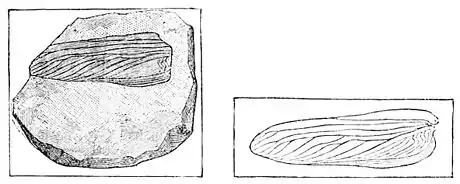THE OLDEST AIR-BREATHERS.
399
found abound in Eurypterids, or fossils of a crustacean allied to the king-crab.
Of the recent discovery of earlier Silurian insects, we have the following account given by M. Charles Brongniart to the French Academy of Sciences:
 Fig. 3.—Fossil Scorpion, from the upper Silurian rocks of Lesmahagow, Lanarkshire, Scotland, found by Dr. Hunter, Carluke. (Magnified two diameters.)
Fig. 3.—Fossil Scorpion, from the upper Silurian rocks of Lesmahagow, Lanarkshire, Scotland, found by Dr. Hunter, Carluke. (Magnified two diameters.)
"Fossil insects have been found in the carboniferous strata. The coal-beds of Commentry have furnished some thirteen hundred specimens, and Mr. Scudder has described six specimens that were found in the Devonian beds of New Brunswick; but, until very recently, no representative of that class had been detected in any of the more ancient formations. M. Douvillé, a professor in the School of Mines, has shown me a piece of Middle Silurian sandstone from Jurques, Calvados, bearing a distinct impression of an insect's wing (Fig. 3). The state of preservation is not perfect, but we can still distinguish most of the nervation. The wing, which is about thirty-five millimetres long, belonged to a blattid, an insect of the cockroach family. The humeral field is broad, and upon it may be seen the superior humeral vein; the inferior humeral vein, bifurcated at its extremity; the vitrean or median vein, likewise divided into
 | ||
| Fig. 3.—Wing of a Fossil Blatta (Palæo-blattina Douvillei). in a piece of Silurian sandstone (natural size). | Fig. 4.—Restoration of the Fossil Wing. | |
two branches; the upper and lower discoidal veins, with their very oblique divisions meeting again at the end, just as they may still be